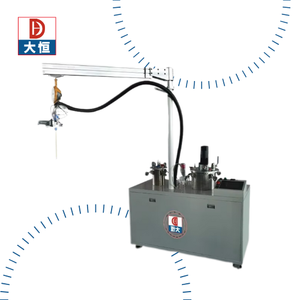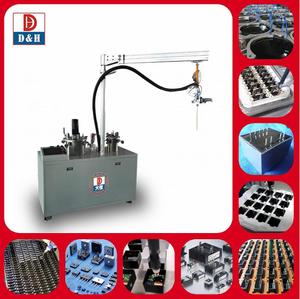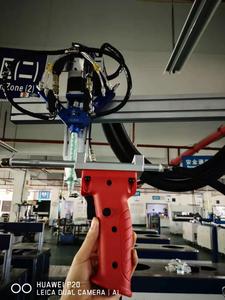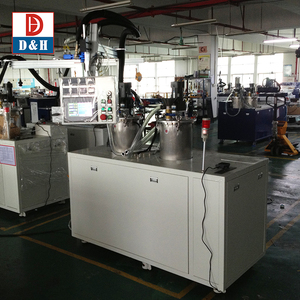
All categories
Featured selections
Trade Assurance
Buyer Central
Help Center
Get the app
Become a supplier

(2162 products available)




















Types of Mixing and Dosing Machines for Polyurethane
A mixing and dosing machine for polyurethane is available in different types that serve distinct purposes when working with the complex chemical components of polyurethane. Each machine combines the requirements of the business that uses it.
Floor-Standing Mixing and Dosing Machine:
The floor-standing mixing and dosing machines have a distinct advantage over fixed ones: they can easily be moved around the production floor. However, that flexibility will be lessened if the machine has to be plugged into a generator or power supply that is not part of the regular equipment used for the material or product.
Single Dosing Unit:
When using a mixing and dosing machine for different materials to be mixed and dosed at the same time, the type of machine with a single dosing is easier to use. It is preferable to have a machine that fulfills more of the production's requirements at a cost-effective price.
Inline Premix and Static Mixer:
An inline premix and static mixer machine combines materials before they are dosed onto a product or workstation. These integrated dosing and mixing solutions streamline production and reduce the number of individual machines that have to be used. Using them offers improved dosing accuracy and ensures that products are brought to market more quickly.
External Static Mixing Tube:
External static mixing tubes combine materials outside the dosing unit. They offer flexibility by using different tube lengths and diameters according to the viscosity and flow of the mix being prepared. Businesses that use them can choose from various tube materials based on the chemical properties of the ingredients.
Multiple Feed Units:
A mixing and dosing machine with many feeding units allows several ingredients to be prepared and supplied simultaneously. They are particularly important in complex formulations in the food industry, chemicals, and cosmetics. These machines boost production capacity by streamlining the preparation and supplying of essential components.
Batch Mixing Units:
Mixing and dosing machines that are used for batch preparation are commonly found in food, pharmaceutical, and chemical manufacturing industries. They accurately weigh ingredients, then mix them to produce homogeneous batches, and finally, they are used to streamline dosing and dispensing. The machines can be programmed to follow specific recipes and ensure consistent product quality while adhering to strict regulatory requirements.
Some specifications concerning mixing and dosing machines for polyurethane include the following:
Maintenance:
When it comes to taking care of the mixing and dosing machines for polyurethanes, regular inspection and cleaning have been revealed to be very essential.
More importantly, users should often perform a thorough cleaning and sanitization of both the dosing and mixing components of the machine. This will help remove any build-up residues of glue, paint, or foam, ensuring the dosing and mixing parts continue to work well.
Lubrication of moving parts of the machine, especially those exposed to friction, is also very essential for maintenance. It helps lessen the wearing process and keeps the parts functioning smoothly.
Users are also advised to calibrate and periodically check the dosage accuracy of the machines, ensuring they are still as precise as when newly bought. This helps maintain consistency in product quality and translates to a more reliable end result. In addition to this, routine software and controls system updates are also crucial to the machine's longevity and optimal performance. With regular updates, bugs causing glitches are fixed, and a new feature is unlocked, thereby enabling the user to get the best out of the mixing and dosing machine for polyurethane. Finally, users should pay close attention to the machine manuals and follow maintenance instructions provided by the manufacturer. This ensures that the most delicate and important parts of the machine are well taken care of.
Mixing and dosing machines for polyurethane are commonly used in the automotive industry to produce car seats, dashboards, door panels, center consoles, etc. Such machines can create lightweight but strong parts that make cars go fast. The mixing and dosing machines can also be used to make automotive insulation materials and sealants.
The construction industry is another significant application area for mixing and dosing machines for polyurethane. Machines in this industry tend to have high throughputs, resulting in large volumes of mixtures per unit time. In the construction industry, mixing and dosing machines for polyurethane are used to make structural components like beams, pipes, and panels. They are also used for building insulation, flooring, and waterproofing.
In the furniture industry, mixing and dosing machines are used to manufacture furniture items such as rigid and flexible furniture, customized furnishings, and decor pieces. In the packaging industry, these machines create shockproof and impact-proof packaging solutions and protective packaging inserts.
Mixing and dosing machines for polyurethane can also be used to make medical devices such as prosthetics and supports. They are also used to produce highly precision items like optoelectronic devices.
Production demands:
When selecting a mixing and dosing machine for polyurethane, a buyer must consider the production requirements. This includes the desired output volume and frequency. A buyer needs to choose a machine that can handle the preferred batch size and supply the output volume as per the business needs. For instance, if a buyer's project involves high-volume production, they may need a machine with a larger capacity or one that offers continuous operation.
Material compatibility:
Materials compatibility is another essential factor to consider when selecting a mixing and dosing machine. The buyer must pick a machine that works well with the particular characteristics of the materials to be mixed. The buyer has to ensure that the machine is capable of properly blending the materials, including fillers and additives, to achieve the desired end product quality.
Machine efficiency:
A buyer needs to select an efficient mixing and dosing machine for polyurethane production to minimize operating costs and maximize productivity. Consider factors that impact a machine's efficiency, such as energy consumption, mixing speed, and precision dosing capabilities. An efficient mixing and dosing machine will help streamline the production process and reduce waste.
Budget constraints:
When it comes to selecting a mixing and dosing machine for polyurethane, a buyer has to consider their budget. Budget constraints may influence the buyer's choice of machine size, specification, and technology. It's important to get a balance between the ideal features and the budget constraints. Even with a limited budget, the buyer can still find a reliable and efficient mixing and dosing machine that meets their production needs.
Future scalability:
Buyers should look for a mixing and dosing machine with flexible options to accommodate future expansion. Such a machine offers the business room to grow without investing in additional equipment soon.
Q1: What are the trends in the mixing machine market?
A1: The market for mixing machines is trending toward smarter, greener, and more efficient machines. Industry 4.0 solutions are making machines more connected and automated, while enhanced energy efficiency is lowering operating costs. Machines are also becoming more versatile, handling a broader range of materials and mixing applications. Eco-friendly mixing solutions, such as polymer mixing for asphalt, are gaining traction amid industrial sustainability efforts.
Q2: What are the three primary mixing methods for liquids?
A2: The three primary mixing methods for liquids are agitator mixing, emulsifier mixing, and homogenous mixing. Agitator mixing involves the use of rotating blades to stir and mix liquids. Emulsifier mixing employs specific devices to disperse and mix immiscible liquids. Homogenous mixing uses a homogenizer to create a uniform mixture of different liquids or to mix liquids with solids.
Q3: What is the definition of dosing in engineering?
A3: In engineering, dosing refers to the system-controlled addition of small quantity of materials or substances into a process or mix to enhance performance, quality, and safety.
Q4: What are the types of mixing in engineering?
A4: There are three main types of mixing in engineering. Homogeneous mixing occurs when materials of similar sizes and densities are mixed to form a uniform composition. Heterogeneous mixing is mixing unlike materials to form a mixture with distinct phases. Selective mixing is the preferential mixing of certain components within a material or mixture.